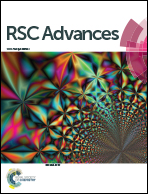Performance and mass transfer of aqueous fluoride removal by a magnetic alumina aerogel†
Abstract
Magnetic alumina aerogel (MAA) was successfully synthesized and evaluated for F− removal from water. The adsorbent was characterized by field emission-scanning electron microscopy (FE-SEM), energy dispersive X-ray spectroscopy (EDX), X-ray diffraction (XRD), vibration sample magnetometry (VSM), X-ray photoelectron spectroscopy (XPS), FTIR, and Raman spectroscopy. The magnetic alumina aerogel sample has a BET surface area of 215.1 m2 g−1 and meso- to macro-sized pores ranging from 50 nm to 200 nm. A saturation magnetization of 19.8 emu g−1 was observed, which makes the separation of the adsorbent realizable after batch adsorption. Boehmite and magnetite phases were identified in the adsorbent. A core–shell structure is favored and additional studies are suggested. Aggregated aerogel nanoparticles composed of boehmite are the inner portion. Magnetite nanoparticles discretely and partly cover the alumina by leaving portions of alumina's surface exposed to the ambient environment. This adsorbent has a moderately high adsorption capacity of 32.1 mg F− per g adsorbent at pH 5.0. Batch studies revealed that fluoride adsorption followed the pseudo-second-order kinetics model. The intraparticle mass diffusion was fitted well using a homogeneous surface diffusion model (HSDM), and the intraparticle surface diffusion coefficients (Ds) were numerically determined. The evolution of dimensionless radial F− concentration profiles inside particles was also simulated. General co-existing anions did not inhibit F− uptake by MAA except for a slight inhibition by HCO3− and PO43−. Spiking experiments demonstrated that MAA effectively removed F− when treating simulated well water contained 1.83 mg L−1 F−. Al 2p and Fe 2p XPS spectra of MAA before and after F− removal demonstrated that both the alumina and iron oxide phases contributed to F− surface adsorption. The adsorption performance and easy separation of MAA show this adsorbent is a promising candidate for fluoride removal from water.



 Please wait while we load your content...
Please wait while we load your content...